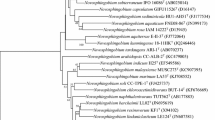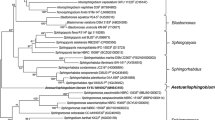Abatract
A Gram-negative, non-motive, aerobic and non-spore-forming strain 16-28-2T isolated from freshwater sediment of Taihu Lake was characterized by using a polyphasic approach. The optimum growth conditions were found to be as follows: 28 °C, pH 6.5 and 0–0.5 % NaCl in YG liquid medium. The major fatty acids were identified to be summed feature 3 (consisting of C16:1 ω7c and/or C16:1 ω6c), summed feature 8 (consisting of C18:1 ω7c and/or C18:1 ω6c), C14:0 2-OH, C17:1 ω6c, C16:0 and C18:1 ω7c 11-methyl (>5 %). Strain 16-28-2T was found to contain diphosphatidylglycerol, phosphatidylglycerol, phosphatidylethanolamine, phosphatidylcholine and sphingoglycolipid as the major polar lipids; and ubiquinone 10 (Q-10) as the major respiratory quinone. DNA G+C content of strain 16-28-2T was 63.5 mol % (Tm). A phylogenetic study of 16S rRNA gene indicated that strain 16-28-2T is a member of the genus Novosphingobium, with the highest 16S rRNA gene sequence similarity of 96.3 % with Novosphingobium lentum MT1T and below 96 % with the other Novosphingobium species. On the basis of the phylogenetic, phenotypic analyses and biochemical characterization, we suggest that strain 16-28-2T is a novel species in the genus Novosphingobium, for which the name Novosphingobium tardum sp. nov. is proposed. The type strain of N. tardum is 16-28-2T (=CGMCC 1.12989T =NBRC 110956T).

Similar content being viewed by others
References
Baker GC, Smith JJ, Cowan DA (2003) Review and re-analysis of domain-specific 16S primers. J Microbiol Methods 55:541–555
Chen Q, Zhang J, Wang C, Jiang J, Kwon SW, Sun L, Shen W, He J (2014) Novosphingobium chloroacetimidivorans sp. nov., a chloroacetamide herbicides-degrading bacterium isolated from activated sludge. Int J Syst Evol Microbiol 64:2573–2578
Colins MD, Goodfellow M, Minnikin D (1980) Fatty acid, isoprenoid quinone and polar lipids composition in the classification of Curtobacterium and related taxa. J Gen Microbiol 118:29–37
Collins MD (1985) Isoprenoid quinone analysis in classification and identification. Chemical methods in bacterial systematic. Academic, London, pp 267–287
Cowan ST, Steel KJ (1965) Manual for the identification of medical bacteria. Cambridge University, London
Dong XZ, Cai MY (2001) Determinative manual for routine bacteriology. Scientific, Beijing
Felsenstein J (1985) Confidence limits on phylogenies: an approach using the bootstrap. Evolution 39:783–791
Fitch WM (1971) Toward defining the course of evolution: minimum change for a specific tree topology. Syst Zool 20:406–416
Gerhardt P, Murray RGE, Wood WA, Krieg NR (1994) Methods for general and molecular bacteriology. American Society for Microbiology, Washington, DC
Glaeser SP, Bolte K, Martin K, Busse HJ, Grossart HP, Kämpfer P, Glaeser J (2013) Novosphingobium fuchskuhlense sp. nov., isolated from the north-east basin of Lake Grosse Fuchskuhle. Int J Syst Evol Microbiol 63:586–592
Kim OS, Cho YJ, Lee K, Yoon SH, Kim M, Na H, Park SC, Jeon YS, Lee JH et al (2012) Introducing EzTaxon-e: a prokaryotic 16S rRNA gene sequence database with phylotypes that represent uncultured species. Int J Syst Evol Microbiol 62:716–721
Kroppenstedt RM (1985) Fatty acid and menaquinone analysis of actinomycetes and related organisms. In chemical methods in bacterial systematics (Society for Applied Bacteriology Technical Series vol. 20). Academic, New York, pp 173–199
Lee JC, Kim SG, Whang KS (2014a) Novosphingobium aquiterrae sp. nov., isolated from ground water. Int J Syst Evol Microbiol 64:3282–3287
Lee LH, Azman AS, Zainal N, Eng SK, Fang CM, Hong K, Chan KG (2014b) Novosphingobium malaysiense sp. nov. isolated from mangrove sediment. Int J Syst Evol Microbiol 64:1194–1201
Li HF, Zou ZT, Li BZ, Wang X, Yang JS, Yuan HL (2012) Novosphingobium sediminis sp. nov., isolated from the sediment of a eutrophic lake. J Gen Appl Microbiol 58:357–362
Lin SY, Hameed A, Liu YC, Hsu YH, Lai WA, Huang HI, Young CC (2014) Novosphingobium arabidopsis sp. nov., a DDT-resistant bacterium isolated from the rhizosphere of Arabidopsis thaliana. Int J Syst Evol Microbiol 64:594–598
Marmur J, Doty P (1962) Determination of the base composition of deoxyribonucleic acid from its thermal denaturation temperature. J Mol Biol 5:109–118
Morohoshi T, Yamashita T, Kato J, Ikeda T, Takiguchi N, Ohtake H, Kuroda A (2003) A method for screening polyphosphate-accumulating mutants which remove phosphate efficiently from synthetic wastewater. J Biosci Bioeng 95:637–640
Saitou N, Nei M (1987) The neighbor-joining method: a new method for reconstructing phylogenetic trees. Mol Biol Evol 4:406–425
Suzuki S, Hiraishi A (2007) Novosphingobium naphthalenivorans sp. nov., a naphthalene-degrading bacterium isolated from polychlorinated-dioxin-contaminated environments. J Gen Appl Microbiol 53:221–228
Takeuchi M, Hamana K, Hiraishi A (2001) Proposal of the genus Sphingomonas sensu stricto and three new genera, Sphingobium, Novosphingobium and Sphingopyxis, on the basis of phylogenetic and chemotaxonomic analyses. Int J Syst Evol Microbiol 51:1405–1417
Tamura K, Peterson D, Peterson N, Stecher G, Nei M, Kumar S (2011) MEGA5: molecular evolutionary genetics analysis using maximum likelihood, evolutionary distance, and maximum parsimony methods. Mol Biol Evol 28:2731–2739
Tiirola MA, Busse H, Kämpfer P, Männistö MK (2005) Novosphingobium lentum sp. nov., a psychrotolerant bacterium from a polychlorophenol bioremediation process. Int J Syst Evol Microbiol 55:583–588
Xie F, Quan S, Liu D, He W, Wang Y, Ma H, Chen G, Chao Y, Qian S (2014) Novosphingobium kunmingense sp. nov., isolated from a phosphate mine. Int J Syst Evol Microbiol 64:2324–2329
Yoon JH, Kim H, Kim SB, Kim HJ, Kim WY, Lee ST, Goodfellow M, Park YH (1996) Identification of Saccharo-monospora strains by the use of genomic DNA fragments and rRNA gene probes. Int J Syst Bacteriol 46:502–505
Zhang D, Yang H, Zhang W, Huang Z, Liu SJ (2003) Rhodocista pekingensis sp. nov., a cyst-forming phototrophic bacterium from a municipal wastewater treatment plant. Int J Syst Evol Microbiol 53:1111–1114
Acknowledgments
This work was supported by the project No.31070105 of the National Natural Science Foundation of China. It was also supported by China Geological Survey Grant (No. 12120113015200).
Author information
Authors and Affiliations
Corresponding author
Electronic supplementary material
Below is the link to the electronic supplementary material.
Rights and permissions
About this article
Cite this article
Chen, N., Yu, XJ., Yang, JS. et al. Novosphingobium tardum sp. nov., isolated from sediment of a freshwater lake. Antonie van Leeuwenhoek 108, 51–57 (2015). https://doi.org/10.1007/s10482-015-0463-x
Received:
Accepted:
Published:
Issue Date:
DOI: https://doi.org/10.1007/s10482-015-0463-x




